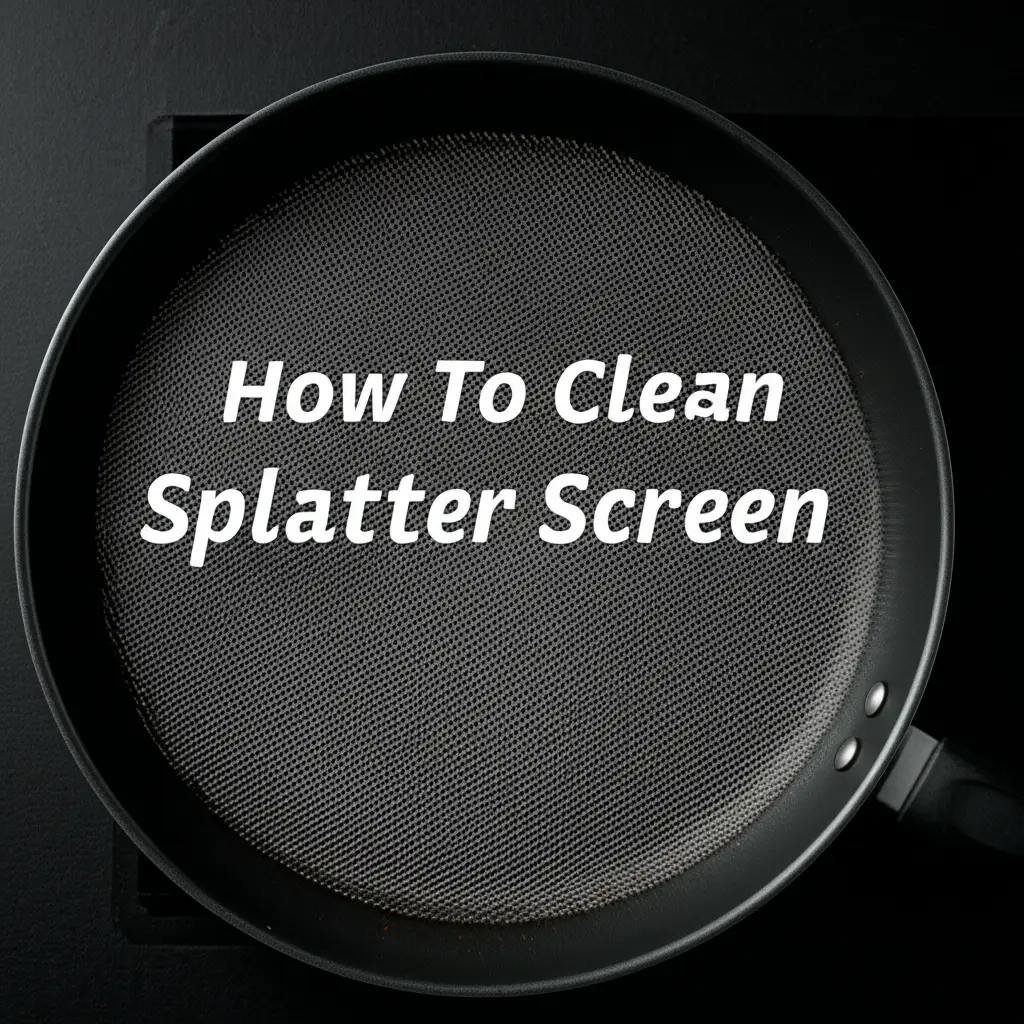· Kitchen Cleaning Tips · 11 min read
How To Clean Splatter Screen

Mastering Splatter Screen Cleaning: A Complete Guide
Cooking often brings joy. However, it also brings oil splatter. That sizzling bacon or frying chicken can quickly coat your stovetop. This is where your trusty splatter screen steps in. It acts as a shield, keeping your kitchen cleaner. Yet, this essential tool collects grease and food particles. A dirty screen loses its effectiveness. It can also harbor bacteria.
Knowing how to clean splatter screen efficiently is important. It ensures your screen performs its job well. It also keeps your kitchen hygienic. This guide provides simple, effective steps. We will cover hand washing, deep cleaning for tough grease, and essential maintenance tips. You will learn the best tools and techniques. Get ready to make your splatter screen spotless.
Takeaway
- Clean your splatter screen after every cooking session.
- Use dish soap and hot water for routine cleaning.
- Apply baking soda paste or a vinegar soak for tough, baked-on grease.
- Always dry your splatter screen completely to prevent rust and mildew.
To effectively clean your splatter screen, begin by scraping off any large food particles. Then, hand wash it thoroughly with hot water and dish soap, using a brush or sponge to scrub the mesh. For stubborn grease, soak the screen in a baking soda solution or create a paste for targeted cleaning. Rinse completely and dry thoroughly to prevent rust.
The Importance of Keeping Your Splatter Screen Clean
Your splatter screen takes a beating in the kitchen. It catches hot oil and food bits. Over time, grease builds up on its fine mesh. This residue can become sticky and hard. A dirty screen is not just unsightly. It also poses problems for your cooking area.
Old grease smells bad. It can even make your food smell. This lingering odor signals bacterial growth. A clean screen blocks splatter better. Its mesh holes remain open and clear. If they are clogged with grease, oil can still escape. Keeping your screen clean makes your kitchen safer. It stops smoke from old grease burning off. I clean my screen after every use. This simple habit keeps it working well. It protects my kitchen surfaces effectively.
Health and Hygiene Benefits
A dirty splatter screen can harbor germs. These germs transfer to your hands. They can also transfer to other kitchen surfaces. Cleaning the screen removes these contaminants. This prevents bacteria growth. It stops cross-contamination in your food preparation area. A clean screen means a healthier kitchen for everyone.
Extending the Life of Your Kitchen Tool
Grease buildup is not just messy. It can also damage your screen. Old, dried grease is corrosive. It weakens the mesh over time. Rust becomes a problem, especially on metal screens. Regular cleaning prevents this damage. It maintains the integrity of the mesh. Your screen will last longer. It will also block grease effectively for many years.
Gathering Your Supplies for Effective Splatter Screen Cleaning
You do not need many special tools. Basic household items work best. These are often already in your kitchen. Having them ready makes the cleaning process simple.
Hot water is essential. It helps dissolve grease quickly. Dish soap is your primary cleaner. Choose a soap known for cutting through grease. A scrub brush or an old toothbrush reaches small spots. These tools get into the mesh. They remove trapped particles. Baking soda and white vinegar are natural helpers. They tackle tough stains. They are effective for deep cleaning. I always have these items ready. They make my splatter screen cleaning easy.
Basic Cleaning Arsenal
Start with the basics. You need a sink with hot water. A bottle of your favorite dish soap is next. Grab a scrub brush with stiff bristles. A sponge with an abrasive side also works well. These items lift everyday grease and food residue. They are gentle enough for the screen’s delicate mesh. This basic setup handles most cleaning tasks.
Natural Boosters for Tough Jobs
For more stubborn grease, turn to natural boosters. Baking soda is a mild abrasive. It absorbs odors and cuts grease. White vinegar is an acid. It dissolves mineral deposits and sticky residue. Together, they create a powerful cleaning duo. Keep a box of baking soda and a bottle of white vinegar handy. They are safe for most screen materials. They offer an eco-friendly cleaning option too.
Hand Washing Your Splatter Screen: A Step-by-Step Guide
Hand washing is a straightforward method. It is highly effective for most splatter screens. This process ensures thorough cleaning. It also protects the screen’s delicate mesh. I often choose hand washing. It gives me complete control over the cleaning process.
First, remove loose food particles. Scrape them gently into the trash can. Do not try to rinse large bits down the drain. This prevents clogs. Next, rinse the screen under hot water. This helps loosen fresh grease. Hot water begins the melting process for the oil.
Apply a small amount of dish soap to your scrub brush. Begin scrubbing both sides of the mesh. Focus on the edges and joints. Grease loves to hide in these areas. Work the brush in small circles. This helps dislodge stuck-on particles. Rinse the screen again until water runs clear. No soap suds should remain. Finally, dry the screen immediately. This prevents water spots or rust. It also helps avoid streaks and keeps your screen shining. I find this method the most reliable for a spotless finish. It is similar to how careful technique prevents streaks when you clean a TV screen without streaks.
Preparing for the Wash
Before you start scrubbing, prepare your screen. Take it to the sink. Hold it over a trash can. Use a paper towel or a soft brush. Gently scrape off any large, solid food bits. This step saves you from dealing with soggy debris later. It also makes the subsequent scrubbing easier.
The Scrubbing Process
Once the screen is free of large particles, it is time to scrub. Get your hot water running. Apply a squirt of dish soap to your chosen cleaning tool. Use a dedicated kitchen brush. Alternatively, use a sponge with a textured side. Scrub the entire mesh surface. Pay close attention to the frame and handle connections. Rinse the brush often to remove accumulated grease. This ensures you are cleaning, not just spreading grease around.
Final Rinse and Dry
After scrubbing, rinse the screen thoroughly. Hold it under hot running water. Make sure all soap suds are gone. You should see clean water flowing through the mesh. Once rinsed, dry the screen immediately. You can air dry it on a dish rack. Alternatively, use a clean towel to wipe it. Complete drying stops rust. It also prevents mildew from forming on the mesh.
Dishwasher Cleaning: Is Your Splatter Screen Dishwasher Safe?
Using a dishwasher to clean your splatter screen offers convenience. However, not all splatter screens are dishwasher safe. It is important to check your screen’s manufacturer’s label. This information tells you if it can withstand high dishwasher temperatures. Most metal screens, like stainless steel, are generally safe. Screens with plastic components might warp or melt.
If your screen is dishwasher safe, place it in the top rack. This protects it from the hottest parts of the dishwasher. Use a normal wash cycle. Avoid using harsh detergents. Dishwashers are convenient for light grease buildup. They might not remove all tough, baked-on grease. I often find that very greasy screens still need a pre-soak or hand scrub.
While dishwashers are great, hand cleaning allows for better attention to detail. This is especially true for stubborn marks. It is much like how specific methods are needed for particular residues. For instance, removing tough marks from a splatter screen requires focused effort. This is similar to the specific attention needed when learning how to clean fingerprints off a TV screen. Both tasks benefit from targeted cleaning approaches.
Deep Cleaning Methods for Stubborn Splatter Screen Grease
Sometimes, regular washing is not enough. Baked-on grease can cling stubbornly to your splatter screen. This type of grease needs extra power. Deep cleaning methods break down these tough residues. They restore your screen to a sparkling condition.
A baking soda paste is a strong cleaner. Mix baking soda with a small amount of water. Create a thick paste. Spread this paste generously on the greasy areas. Let it sit for 15 to 30 minutes. The baking soda works to absorb the grease. It also acts as a gentle abrasive. After soaking, scrub the screen firmly. The paste helps lift the grease. This makes scrubbing more effective.
Vinegar soaks also work wonders. Submerge your screen in a basin of hot water mixed with white vinegar. Use a 1:1 ratio of water to vinegar. Let it soak for an hour or even longer for very tough stains. The acid in the vinegar dissolves the grease. After soaking, scrub and rinse the screen thoroughly. These methods break down tough, sticky grease. They leave your screen looking almost new. They help your screen shed sticky residues, much like how specific methods are used to clean the sticky side of a screen protector. For very stubborn stains, you might need a second treatment. Just like some external screens require specific remedies for tough marks. This includes challenges like knowing how to clean algae from a pool screen enclosure, where targeted solutions are key.
The Baking Soda Power Boost
Baking soda is a kitchen miracle worker. For deep cleaning, make a thick paste. Combine a few tablespoons of baking soda with just enough water. The paste should be spreadable. Apply it directly onto the caked-on grease. Ensure full coverage. Let it sit for at least 15 minutes. For older, tougher stains, leave it for a few hours. The longer it sits, the more it breaks down the grease. After soaking, use a stiff brush to scrub. The mild abrasion helps lift the softened grime.
Vinegar Soak for Extra Shine
White vinegar is another powerful, natural cleaner. For a deep soak, fill your sink or a large basin. Use equal parts hot water and white vinegar. Submerge your splatter screen completely. Let it soak for at least an hour. You can even leave it overnight. The vinegar’s acidity cuts through grease and grime. It also helps remove any lingering odors. After soaking, take the screen out. Give it a good scrub with dish soap. Rinse it thoroughly. Your screen will be clean and shiny.
Maintaining Your Splatter Screen for Lasting Cleanliness
Regular cleaning is good. But daily maintenance is better. It keeps your splatter screen in top shape. It also prevents heavy grease buildup. A quick wipe after each use saves deep cleaning time later. This simple habit preserves your screen’s effectiveness.
Make it a rule: clean your splatter screen after every use. Do not let grease dry and harden. A quick rinse under hot water and a wipe with a soapy sponge often prevents buildup. This saves you from tougher scrubbing jobs later. Store your screen properly. Hang it on a hook. Or, lay it flat in a cabinet. Avoid stacking other items on it. This can bend the mesh. Inspect your screen regularly. Look for any signs of damage. Good habits make cleaning easy. They extend the screen’s life. I always clean my screen right after cooking. This small effort makes a big difference in maintaining its cleanliness. Regular maintenance ensures your screen remains effective. It is a simple habit that pays off.
Post-Cooking Routine
Establish a post-cooking routine. As soon as your pan cools, attend to the splatter screen. Do not let the grease solidify. A simple rinse with hot water can wash away fresh oil. Follow with a quick scrub using dish soap. This takes less than a minute. It prevents grease from hardening onto the mesh. This immediate action drastically reduces future cleaning effort.
Proper Storage Tips
After cleaning and drying, store your splatter screen correctly. Proper storage helps maintain its shape. It prevents damage to the delicate mesh. Hang it on a wall hook. This allows for air circulation. Alternatively, lay it flat in a drawer. Ensure no heavy items rest on top of it. This prevents bending or warping. A well-stored screen stays ready for its next use. It also lasts longer.
Frequently Asked Questions About Splatter Screen Cleaning
How often should I clean my splatter screen?
Clean your splatter screen after every use. Fresh grease is easier to remove than dried, baked-on residue. Regular cleaning prevents buildup, maintains hygiene, and extends the life of your screen. A quick wash after cooking saves time later and keeps your screen ready.
Can I put my splatter screen in the dishwasher?
It depends on the screen’s material. Many metal splatter screens are dishwasher safe. Always check the manufacturer’s instructions or care label first. Avoid placing screens with plastic components in the dishwasher, as high heat can cause warping or melting.
What if my splatter screen has baked-on grease?
For baked-on grease, try a deep cleaning method. Create a paste with baking soda and water, apply it to the greasy areas, and let it sit for 15-30 minutes. Then, scrub vigorously with a stiff brush. Alternatively, soak the screen in hot water mixed with white vinegar.
- splatter screen cleaning
- kitchen cleaning
- grease removal
- cooking tools
- home cleaning




